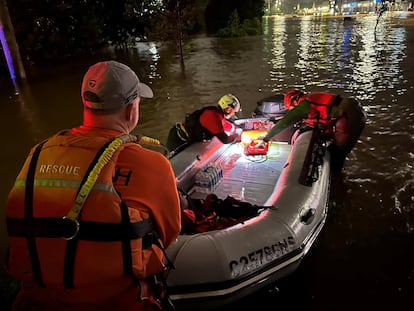Four missing after record-breaking downpours along Canada’s Atlantic coast cause flooding
Torrential downpours started on Friday afternoon across the Halifax region, dumping more than 200 millimeters of rain in some areas

Four people are missing after intense thunderstorms dumped record amounts of rain across a wide swath of Canada’s Atlantic-coast province of Nova Scotia over the past two days, causing flash flooding, road washouts and power outages.
The floods submerged multiple vehicles, and Royal Canadian Mounted Police spokeswoman Cindy Bayers said two such incidents in West Hants north of Halifax have left two adults and two children unaccounted for as of Saturday morning.
The two children went missing after the vehicle they were travelling in got stuck underwater, Bayers said, noting the three other occupants were able to escape safely.
Two other individuals, who Bayers described as a youth and a man, remain unaccounted for following a separate vehicle submersion. Two other people in that vehicle were rescued, she said, adding police are actively searching for all four missing people.
Torrential downpours started on Friday afternoon across the Halifax region, dumping more than 200 millimeters of rain in some areas. The port city typically receives about 90-100 mm of rain during an average July.
Based on radar estimates and unofficial observations, Environment Canada said on Saturday that some areas may have received more than 300 mm in 24 hours. Radar maps show the heaviest rainfall extending along the province’s southwestern shore to a point north of Halifax.
Widespread flooding has also been reported in Lunenberg County, which is west of the Halifax region.
On Friday night, water levels rose so fast in the Bedford area that volunteers with Halifax Search and Rescue were using small boats to rescue people from inundated homes.
In the Hammonds Plains area, northwest of the city, flooding washed out driveways and the shoulders of many roads.
That’s the same area where 151 homes and businesses were destroyed by a wildfire that started on May 28, forcing evacuations that affected 16,000 residents. And for much of the past week, the Halifax area has been sweltering under an immobile dome of humidity — a rare event so close to the coast.
It was only last fall that post-tropical storm Fiona descended on the Atlantic region, killing three people, flattening scores of homes and knocking out power to more than 600,000 homes and businesses. Fiona was the most costly weather event in the region’s history, causing more than 800 million Canadian dollars ($604 million) in insured damage.
“It’s pretty obvious that the climate is changing — from Fiona last year to the wildfires in the spring and now flooding in the summer,” Halifax Mayor Mike Savage said.
“We’re getting storms that used to be considered one-in-50-year events ... pretty regularly,” he added.
While the official statistics have yet to be recorded, it’s believed the Halifax region has not seen this level of rainfall since Aug. 16, 1971, when hurricane Beth made landfall near the eastern tip of mainland Nova Scotia and then roared over Cape Breton. At that time, almost 250 mm of rain fell on the Halifax area, causing widespread flooding and damage.
Sign up for our weekly newsletter to get more English-language news coverage from EL PAÍS USA Edition
Tu suscripción se está usando en otro dispositivo
¿Quieres añadir otro usuario a tu suscripción?
Si continúas leyendo en este dispositivo, no se podrá leer en el otro.
FlechaTu suscripción se está usando en otro dispositivo y solo puedes acceder a EL PAÍS desde un dispositivo a la vez.
Si quieres compartir tu cuenta, cambia tu suscripción a la modalidad Premium, así podrás añadir otro usuario. Cada uno accederá con su propia cuenta de email, lo que os permitirá personalizar vuestra experiencia en EL PAÍS.
¿Tienes una suscripción de empresa? Accede aquí para contratar más cuentas.
En el caso de no saber quién está usando tu cuenta, te recomendamos cambiar tu contraseña aquí.
Si decides continuar compartiendo tu cuenta, este mensaje se mostrará en tu dispositivo y en el de la otra persona que está usando tu cuenta de forma indefinida, afectando a tu experiencia de lectura. Puedes consultar aquí los términos y condiciones de la suscripción digital.
More information
Archived In
Últimas noticias
Pinochet’s victims grapple with José Antonio Kast’s rise in Chile
Reinhard Genzel, Nobel laureate in physics: ‘One-minute videos will never give you the truth’
How Japan is trying to avert ‘digital defeat’
The complicated life of Francesca Albanese: A rising figure in Italy but barred from every bank by Trump’s sanctions
Most viewed
- Pablo Escobar’s hippos: A serious environmental problem, 40 years on
- Why we lost the habit of sleeping in two segments and how that changed our sense of time
- Charles Dubouloz, mountaineering star, retires at 36 with a farewell tour inspired by Walter Bonatti
- Trump’s obsession with putting his name on everything is unprecedented in the United States
- The Florida Keys tourist paradise is besieged by immigration agents: ‘We’ve never seen anything like this’










































